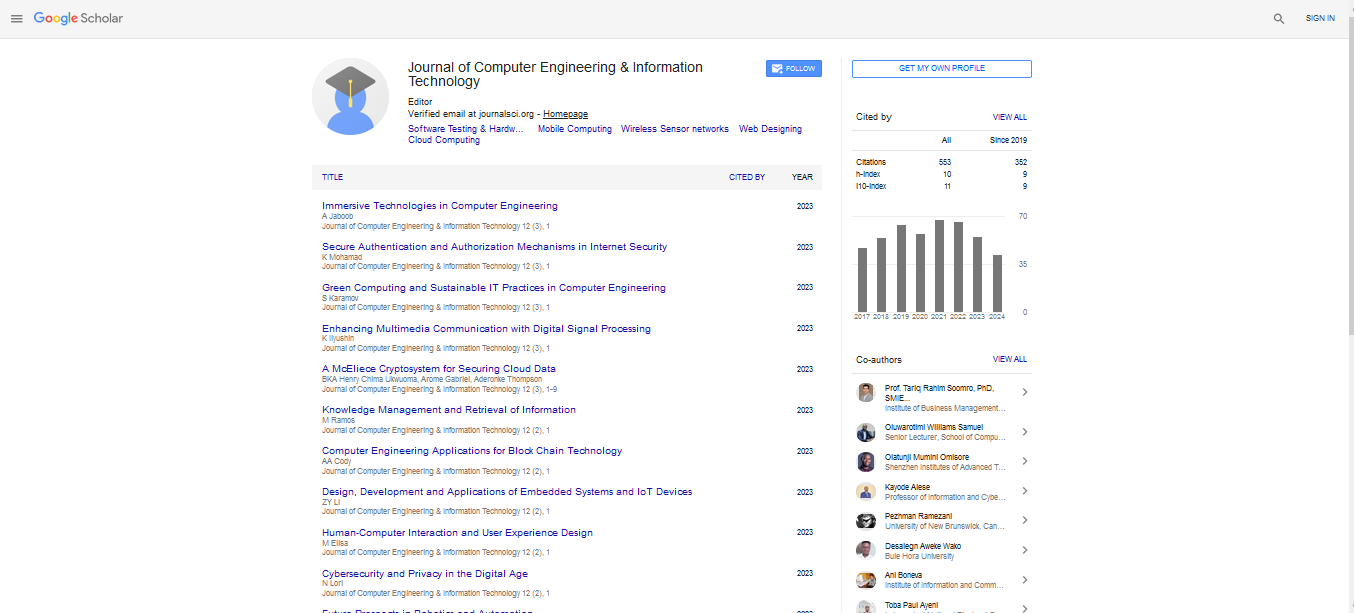Editorial, Jceit Vol: 14 Issue: 2
Ransomware Protection: Defending Against the Digital Extortion Epidemic
Deepa Kanmani*
Department of Information Technology, Sri Krishna College of Engineering and Technology, India
- *Corresponding Author:
- Deepa Kanmani
Department of Information Technology, Sri Krishna College of Engineering and Technology, India
E-mail: deepa_k7658@gmail.com
Received: 01-March-2025, Manuscript No jceit-25-169320; Editor assigned: 4-March-2025, Pre-QC No. jceit-25-169320 (PQ); Reviewed: 20-March-2025, QC No jceit-25-169320; Revised: 27-March-2025, Manuscript No. jceit-25-169320 (R); Published: 31-March-2025, DOI: 10.4172/2324-9307.1000342
Citation: Deepa K (2025) Ransomware Protection: Defending Against the Digital Extortion Epidemic. J Comput Eng Inf Technol 14: 342
Introduction
In today’s interconnected world, data is currency—and cybercriminals know it. Among the most disruptive and fast-growing cyber threats is ransomware, a malicious software that encrypts a victim’s data and demands a ransom in exchange for its release. No longer confined to individual users, ransomware attacks now target hospitals, schools, city governments, and multinational corporations, causing widespread disruption and financial losses [1].
As cybercriminals become more sophisticated, so must our defenses. Ransomware protection is no longer a luxury—it is a strategic necessity. Organizations of all sizes must adopt a proactive, layered approach to cybersecurity that includes prevention, detection, response, and recovery. The cost of inaction is simply too high.
Understanding the Ransomware Threat
Ransomware attacks typically begin with a phishing email, an exposed vulnerability, or compromised credentials. Once inside a system, the malware encrypts critical files, rendering them inaccessible. Victims are then presented with a ransom note—often demanding payment in cryptocurrency—along with threats of permanent data loss or public exposure if payment is not made.
The stakes are enormous. According to Sophos’ 2024 State of Ransomware report, 66% of organizations worldwide were hit by ransomware in the past year, and the average cost of recovery exceeded $1.8 million. Some of the most devastating attacks—such as the Colonial Pipeline hack in 2021—demonstrated how ransomware can cripple infrastructure and disrupt daily life [2].
Ransomware gangs have also evolved their tactics. Many now employ double extortion, stealing sensitive data before encrypting it, and threatening to publish it unless a ransom is paid. This shift has made simple data backups insufficient as a sole defense strategy.
Best Practices for Ransomware Protection
To combat the growing threat, organizations must adopt a multi-layered defense strategy. Key components include:
Employee Awareness and Training
Human error is the most common entry point for ransomware. Regular training in phishing awareness, password hygiene, and social engineering [3] defense can reduce the risk significantly.
Endpoint and Network Security
Deploying endpoint detection and response (EDR) tools, firewalls, and intrusion detection systems (IDS) can help detect and isolate malicious activity before it spreads.
Patch Management
Keeping software and systems up to date is essential. Many ransomware attacks exploit known vulnerabilities that remain unpatched.
Data Backup and Recovery
Regularly backing up critical data—and storing it offline or in immutable formats—ensures that organizations can recover without paying ransoms.
Zero Trust Architecture
Implementing Zero Trust principles ensures that no user or device is trusted by default, reducing lateral movement within networks [4].
Incident Response Planning
Having a documented and regularly tested incident response plan helps organizations respond quickly and effectively, minimizing damage.
The Role of Regulation and Collaboration
Governments and cybersecurity agencies are increasingly stepping in to combat ransomware. In the U.S., the Cybersecurity and Infrastructure Security Agency (CISA) has issued guidelines and launched public-private partnerships to promote cyber resilience. The European Union has expanded its NIS2 Directive to enhance cybersecurity standards across critical sectors.
International cooperation is also on the rise [5]. In 2023, the Counter Ransomware Initiative, a coalition of over 40 countries, pledged to refuse ransom payments and improve intelligence sharing to track down ransomware actors.
However, enforcement alone is not enough. Organizations must take ownership of their security posture and invest in modern defenses. Cybersecurity is not merely an IT issue—it is a business imperative.
Conclusion
Ransomware is no longer an emerging threat—it is a full-blown crisis affecting every sector and geography. As attacks grow more sophisticated and damaging, protection strategies must evolve from reactive to proactive. A comprehensive approach combining technology, training, policies, and international cooperation is essential to mitigate the risk.
Organizations that fail to prepare are not just risking data loss—they’re risking reputational damage, legal consequences, and operational paralysis. Ransomware protection is not a one-time investment, but a continuous commitment to resilience in an era of digital uncertainty.
References
- Sophos (2024) The State of Ransomware 2024.
- US Cybersecurity and Infrastructure Security Agency (CISA) (2021) Ransomware Guide.
- European Commission (2023) The NIS2 Directive Explained.
- IBM Security (2024) Cost of a Data Breach Report 2024.
- White House (2023) Counter Ransomware Initiative Joint Statement.
Indexed at, Google Scholar, Crossref
Indexed at, Google Scholar, Crossref
Indexed at, Google Scholar, Crossref
Indexed at, Google Scholar, Crossref
 Spanish
Spanish  Chinese
Chinese  Russian
Russian  German
German  French
French  Japanese
Japanese  Portuguese
Portuguese  Hindi
Hindi 